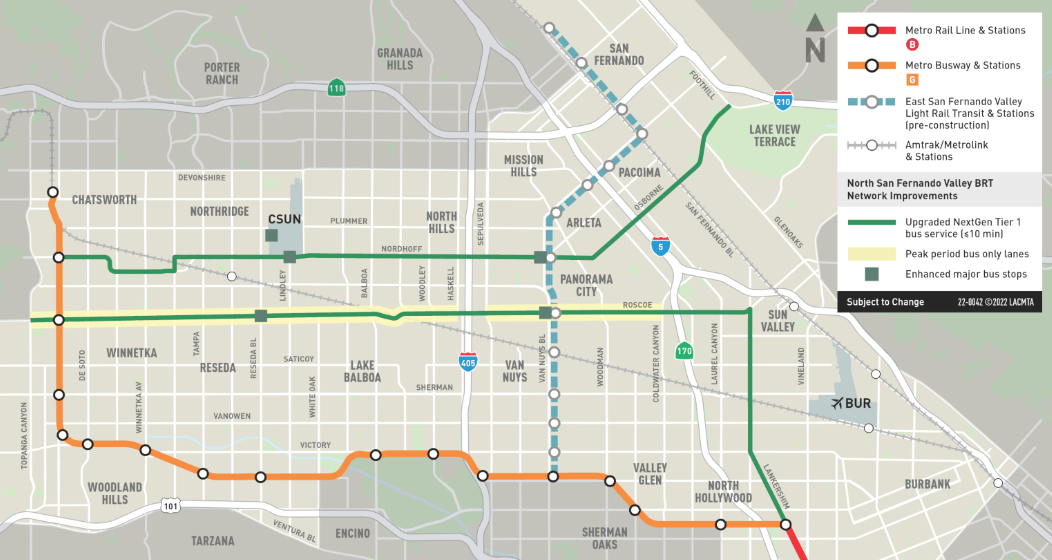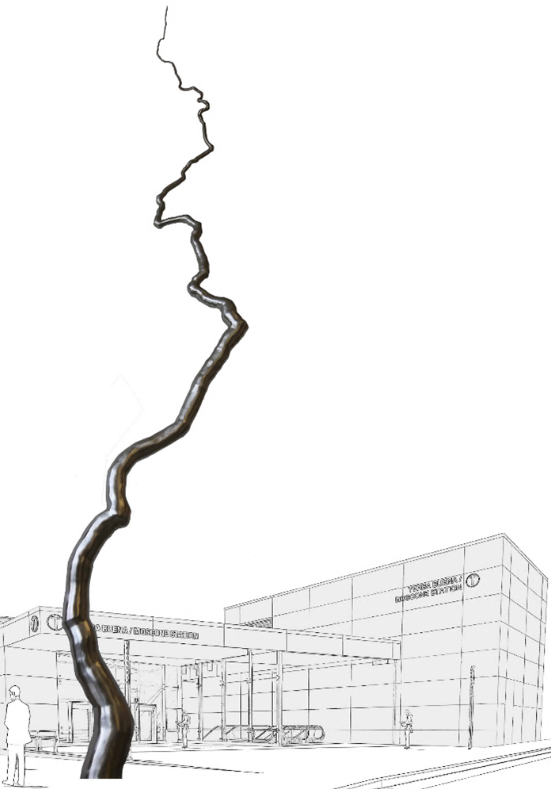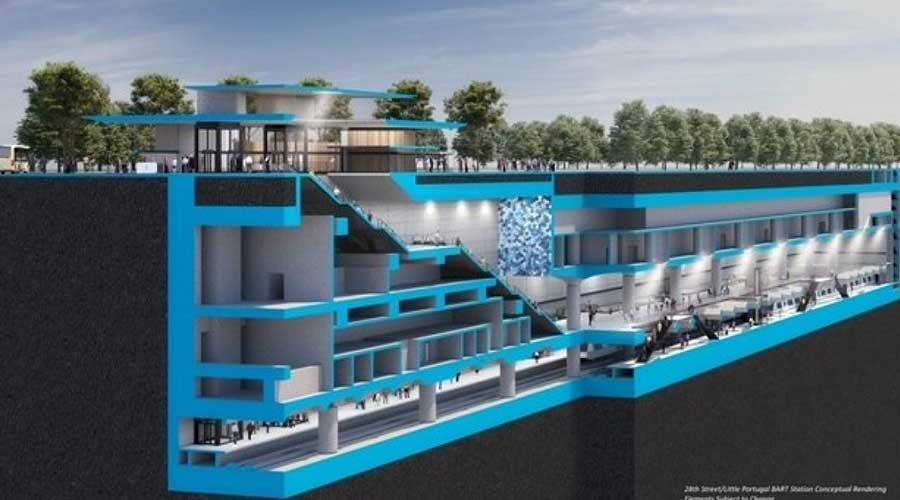The following items are excerpted or summarized from news releases issued by the California Transit Association members. If you are a member of the Association and would like to submit an item to be considered for inclusion in the Member News Library, please email your press releases to Managing Editor Jacob Herson (jake@caltransit.org). Photos and cutline information with your news release submissions, when possible, are encouraged.
LA Metro Board Approves Plan to Improve North San Fernando Valley East-West Bus Service 
The Los Angeles County Metropolitan Transportation Authority (LA Metro) Board approved the $180-million implementation plan for the North San Fernando Valley Transit Corridor to improve the speed, reliability, and passenger experience for bus services on major thoroughfares throughout the San Fernando Valley. The implementation plan is expected to begin in fall 2023 and be completed by winter 2025.
The Board’s approval also gives the project environmental review clearance through an exemption from the California Environmental Quality Act under Senate Bill 288.
The new Bus Rapid Transit network changes will improve connectivity between Valley transit services. As part of the plan, peak period bus priority lanes will be implemented on Roscoe Boulevard, weekday service will be improved to a 10-minute frequency on both Roscoe Boulevard and Nordhoff Street, and new bus shelters will be installed at nearly 400 Valley locations. Five key passenger transfer locations will see enhanced bus stop facilities with larger shelters, more seating, better lighting, and real-time information.
The primary corridors where improvements will be made include Roscoe Boulevard, Nordhoff Street, Lankershim Boulevard, Reseda Boulevard, Sherman Way, Vanowen Street, and Victory Boulevard. The project also provides improved connectivity with stops in Panorama City, Northridge, and California State University, Northridge.
The plan also includes transit signal priority to reduce travel times for seven bus lines: 152, 162, 164, 165, 166, 224, and 240. In addition, 75 new battery-electric zero-emission buses will be purchased to fully electrify four Valley bus lines. All buses will be equipped with TAP validators at their rear doors to allow all-door boarding.
The project also provides many improvements for more transit-dependent customers who live in the Valley’s equity-focused communities. Reliable, on-time, frequent, and faster transit options will improve customer access to work, school, healthcare, daycare, and many other necessary destinations.
The project adds to a growing list of projects now underway in the San Fernando Valley that will bring more transit service the region’s 1.9 million residents. Metro broke ground on advanced utility work for the East San Fernando Valley Light Rail Transit Project on December 2. To be built in two phases, the project will add 14 new stations between the G Line (Orange) Van Nuys Station and the Sylmar/San Fernando Metrolink Station.
The funding for the North San Fernando Valley Transit Corridor Project is provided by the Measure M transportation sales tax measure approved by voters in 2016. Measure M funds projects that ease traffic, expand public transportation, and repair local streets and sidewalks.
“This plan will make it easier for Valley residents to travel with greater reliability, ease, and comfort on Metro buses, and it will provide better east-west transit service with improved access to jobs, education, and essential services,” said Glendale City Council Member and Metro Board Chair Ara J. Najarian. “By increasing the frequency of service and adding new bus shelters and zero-emission buses, this is a game changer for mobility and sustainability in the Valley.”

SFMTA Unveils Public Art in New Central Subway Station
The San Francisco Municipal Transportation Agency (SFMTA) has unveiled new public art at the Yerba Buena/Moscone Station of the new Central Subway.
The art was commissioned by the San Francisco Arts Commission and funded by the City’s Art Enrichment Ordinance, which allocates two percent of the total eligible costs of public works projects for public art. The Yerba Buena/Moscone Station includes artwork by Catherine Wagner, Leslie Shows, and Roxy Paine. The installations can be found on the station's surface and concourse levels.
Catherine Wagner transformed photographs she took in the late 1970s that document the monumental construction of the George Moscone Convention Center, and focus on ideas of transformation. Titled Arc Cycle, the artwork reproduces several iconic images from this photographic series, translating them into laser-etched granite at the concourse level, and art glass at the station’s entry.
Leslie Shows created Face C/Z, installed in the ticketing hall on the concourse level. Based on an image of iron pyrite made with a consumer grade scanner, the artwork was hand fabricated in a unique style combining mirrored, fused, painted, and engraved glass, sheet metal, and other permanent materials. The pyrite (or "fool's gold") image speaks to ever-shifting notions of value in industry and aesthetics, the many historical "gold rushes" of California, and the idea that anything might be made valuable under the right circumstances.
Roxy Paine created a monumental, 110-foot sculpture for the public plaza at 4th and Clementina streets outside of the station. Titled Node, the artwork is conceived to emerge from the complex manmade structures existing beneath the sidewalk, including the subway, communication networks, electrical and water supply, and waste systems that are all lifelines of a functioning city. According to Paine, the sculpture is "an elegant line connecting earth to sky, people to underground systems, and sculpture to city." Node is expected to be installed in early 2023.
All four of the new Central Subway stations will eventually unveil artworks.
BART Approves Developer for North Berkeley Transit-Oriented Development
San Francisco Bay Area Rapid Transit (BART) has taken another major step toward creating new housing just steps from the North Berkeley Station. On December 1, the Board of Directors gave the General Manager authority to enter into a two-year Exclusive Negotiating Agreement (ENA) with BRIDGE Housing Corporation to begin planning a Transit-Oriented Development (TOD).
The TOD would be built on about 5.5 acres of BART-owned land surrounding the station, including the main passenger parking area. A vision document adopted by both BART and the City of Berkeley anticipates 500 to 1,200 homes on BART’s property at North Berkeley, at least 35 percent of which would be affordable.
“Every time I’m at North Berkeley Station, I look around and imagine housing replacing the sea of nearly empty parking lots, and it brings me so much joy,” said BART Board President Rebecca Saltzman. “With today’s action by the BART Board, the dream of more housing — especially affordable housing near BART — is closer than ever to becoming reality.”
The City of Berkeley has expressed strong support for the project and, in April 2021, its City Council pledged $53 million as the subsidy needed to achieve at least 35 percent affordable housing at North Berkeley TOD, as well as at a future project planned at Ashby Station.
BRIDGE Housing, the largest nonprofit developer of affordable and workforce homes on the West Coast, formed a team with three other developers: Oakland-based East Bay Asian Local Development Corporation (EBALDC), which is advancing affordable housing at BART’s Lake Merritt Station; homeless service provider Berkeley Food and Housing Project; and AvalonBay, which completed over 600 apartments at Pleasant Hill BART.
Following a Request for Qualifications that BART issued last July, this team was selected due to its wealth of experience, its leadership by a nonprofit organization, and members’ strong track record with engaging communities during the planning of new homes.
Early in 2023, BRIDGE’s team is expected to share its preliminary plan for the development at North Berkeley BART to get community input. Ideas and feedback from neighbors will be considered as the design for new homes and amenities is refined. Construction would be completed in several phases, with the first phase starting in 2025 or later. Some of the existing BART parking could be replaced within the new buildings.
In the event that BART is unable to advance this development with BRIDGE’s team, the Board authorized staff to enter into an ENA with the second-ranked team, led by Republic Metropolitan.
VTA Receives FTA Approval to Pursue Federal Funding for BART Silicon Valley Extension 
The Santa Clara Valley Transportation Authority (VTA) has received approval to pursue federal funding for up to 50 percent of the cost of Phase II of the BART Silicon Valley Extension Project. The funding could be as much as $4.6 billion, if needed, for the alignment that will extend the heavy rail service from Berryessa/North San Jose through Downtown San Jose into Santa Clara.
The Federal Transit Administration (FTA) notified VTA that the Phase II Project has been approved to re-enter the federal Capital Investment Grants New Starts Funding program. This approval allows VTA to apply for twice the amount of funding anticipated under the previous Expedited Project Delivery pilot program. The FTA’s action also approves past eligible expenses for potential grant reimbursement back to March 2016, as well as for all remaining work on the project, for the estimated total project cost of up to $9.3 billion.
With consideration of the FTA’s actions, VTA’s Board of Directors authorized the execution of contract amendments for up to $460 million at its Thursday night meeting, including the purchase of the tunnel boring machine and moving into early construction activities.
Kiewit Shea Traylor has the tunnel and trackwork contract for the project and plans to procure a tunnel boring machine, approximately 54 feet in diameter, to bore a five-mile tunnel under Downtown San Jose. VTA is embarking on the first rail project in the United States to be constructed by a single bore, allowing both tracks and station platforms to be constructed within the tunnel, utilizing the newest technology in underground construction.
VTA plans to begin the federal funding application as soon as summer 2023, after a final cost estimate and funding plan is worked out. VTA is seeking an additional $750 million from the state’s transportation funding program for major transit projects as the last key funding piece.
The Phase II Extension includes six miles of track and four stations to be added to the Phase I 10-mile alignment from the Warm Springs/South Fremont Station, through Milpitas and Berryessa/North San Jose.
Four Newly Elected or Reelected AC Transit Board Members Take Office
The Alameda-Contra Costa Transit District (AC Transit) announced the election and re-election of four members to its policymaking Board of Directors. The Directors assumed a four-year term, which began December 2.
“When we can get to and from essential places reliably, we can do more with our lives and access more opportunities," said Sarah Syed, Director-elect representing Ward 3, which spans the entire City of Alameda, most of the city of San Leandro, and the southeast portion of Oakland. Born in rural Texas to a Polish-Pakistani family, Syed earned two master’s degrees in City Planning and Transportation Engineering at UC Berkeley. She applied her sound academic training in the building of light rail and better bicycle access for both BART and the Santa Clara Valley Transportation Authority. As a transit planner, Syed developed bus rapid transit in Los Angeles and advanced safe routes to schools in Oakland and Berkeley.
“AC Transit is a lifeline for people with disabilities, students, seniors, and low-income residents. I know this reality firsthand. As an Oakland native, AC Transit was my family’s only mode of transportation,” said Murphy McCalley, Director-elect representing Ward 4, which spans portions of Hayward, San Leandro, and unincorporated areas of Castro Valley and the surrounding areas. Director McCalley was initially appointed by the Board of Directors last April, where he advocated for low fares for seniors, people with disabilities, East Bay youth, and low-income riders, while simultaneously protecting quality jobs in transit. McCalley holds a bachelor's and a master’s in Public Administration and has been a change agent for transit agencies across California for more than 30 years. McCalley was elected in November by an overwhelming majority of Ward 4 voters.
“In 2018, during my first election cycle, I stressed that mobility needs in our area have changed and directly advocated for more flexibility. I had no idea how those words would foreshadow the pandemic's disastrous effects on transit, and the resilient re-engineering AC Transit has and will continue to invest toward recovery," says Diane Shaw, the incumbent re-elected to represent Ward 5, which spans the Cities of Fremont and Newark and a small portion of Hayward. A retired Information Technology Manager for the San Mateo County Transit District, Shaw is a lifelong user of public transit, regularly riding the Dumbarton Express bus from Fremont-Newark to San Carlos. Shaw received her bachelor’s in Business and Computer Science from Minnesota State University, Mankato, and was first elected to the AC Transit Board of Directors in November 2018.
“AC Transit has helped bolster the East Bay's infrastructure throughout the pandemic. Essential workers, transit-dependent riders, and students rely on us, and with each ride, we have re-earned our riders’ trust. As I return to the Board, my focus is deficits and how to improve funding for our invaluable service,” said Joel Young, the incumbent re-elected as At-Large Director. Young has emerged as one of the Board of Directors’ longest-tenured policymakers, having been first appointed in February 2009 to fill one of the transit district’s two at-large positions. He was elected by the voters in 2010, re-elected to serve additional terms in 2014 and 2018, and had a convincing win in November 2022. Young earned his bachelor’s degree from UC Berkeley and his Juris Doctor from the UC Berkeley School of Law.
Santa Maria Regional Transit Ridership Up 31 Percent
Santa Maria Regional Transit (SMRT) announced that its ridership is up 31 percent for 2022, compared with the same period last year.
“Many routes have doubled in ridership from the start of the year,” said Transit Services Manager Gamaliel Anguiano said. “We are excited to see our riders come back as well as many new riders joining the ranks. We will continue to do more for our City and are sure many will appreciate the innovative public transit improvements still to come, like our micro-mobility project.” Anguiano received the California Transit Association’s 2022 Transit Professional of the Year Award, which honors an outstanding individual who has provided strong leadership and vision.
Steps taken by SMRT to help drive ridership recovery include route improvements, a price reduction of the monthly pass to $31, the introduction of a new $3 unlimited-ride One-Day Pass, and $12 unlimited-ride Seven-Day Pass, and a mobile ticketing option via the SMRTpay app.
The agency also launched its first two electric buses in November of this year. SMRT will achive a 100-percent electric fleet with the launch of 16 more electric buses, scheduled to be delivered by 2024. The new buses will come with upgraded safety, security, and passenger comfort amenities.
WETA Achieves 99 Percent Passenger Satisfaction Rating
Ninety-nine percent of San Francisco Bay Ferry riders are satisfied with the service according to data released by the San Francisco Bay Area Water Emergency Transportation Authority (WETA) from its 2022 passenger survey. The rating makes the service the highest-rated transit system in the nation.
The survey, conducted in July and August 2022 by CDM Smith, collected important information from a statistically valid sample of 963 San Francisco Bay Ferry passengers to help identify changes in rider demographics and sentiments in the wake of major fare cuts and service increases as a part of WETA’s Pandemic Recovery Program, instituted in July 2021.
The survey’s findings include:
- 99 percent rider satisfaction, WETA’s highest figure ever and up from 88 percent in 2017.
- 42 percent of passengers surveyed are new ferry riders who did not use the service before 2020, indicating the positive impact of the Pandemic Recovery Program on growing ridership.
- A significant increase in riders citing affordability as a reason they choose the ferry over other travel modes, from 7 percent in 2017 to 18 percent in 2022.
“It’s hard to do better than 99 percent, and we have the excellent work of our captains and crews to thank,” said WETA Executive Director Seamus Murphy. “In an effort to maximize ridership return, we’ve prioritized passenger experience over the last year, and it’s great to see those efforts pay off. I’m especially proud that the number of riders who are ‘very satisfied’ with the service has doubled during pandemic recovery from 38 percent to 76 percent.”
San Francisco Bay Ferry has hit nearly 80 percent of pre-pandemic ridership in each of the past three months, standing well ahead of comparable regional transit operators. The ferry system currently offers 152 weekday transbay trips and 57 weekend departures.